 
are all terms being bandied about even by some of the area’s more staid social and cultural institutions as they welcome boardmembers from among the new power elite, capitalize on the region’s strong economy, and exploit modern technology to furthertheir long-range goals. An alliance of blue blooded traditionalists and new economy technocrats is working together to affecta comprehensive social and cultural renaissance in the Washington, D.C., area. Using innovative means and state-of-the-arttechnology, the diversified boards of local cultural and charitable institutions are furthering an unprecedented number ofartistic, educational, and humanitarian projects. Washington Life checked on a cross-section of boards and theirmemberships to see how each is changing, and helping to create the cultural and social landscape of the new century.THE JOHN F. KENNEDY CENTER FOR THE PERFORMING ARTS
Encouraged by record economic prosperity both locally and nationwide, the Kennedy Center’s board of trustees is currently inthe midst of an unprecedented $100 million endowment drive to achieve financial security and provide increasingly affordableand diverse programs to an ever broader audience. Eager to be of assistance, James V. Kimsey, AOL’s founding CEO and chairmanemeritus, made headline news in the spring of 2000 when as a member of both the Kennedy Center and National Symphony Orchestraboards, he committed a record-breaking $10 million to the Center and its musical affiliate. As the largest single contributionin the Center’s 29-year history, the gift effectively doubled its endowment, helping to promote what Kimsey describes as “arenaissance in the arts.”The bulk of Kimsey’s donation is ear-marked to give every fifth grade District student the opportunity to attend a KennedyCenter performance, a goal which reflects the growing effort among area boards to extend their outreach programs to lessprivileged segments of the population, and inspire the next generation of artists. The handsome gift should, as Mayor AnthonyWilliams put it, “make the arts come alive for children.” The National Symphony Orchestra receives $1.5 million of the totalto endow the principal tuba chair. Thanks to the support of Kimsey and others, $70 million has now been committed in the endowment drive. However, reaching the$100-million mark, a figure commensurate with the Center’s annual operating costs, may become the responsibility of numerousnew board members. 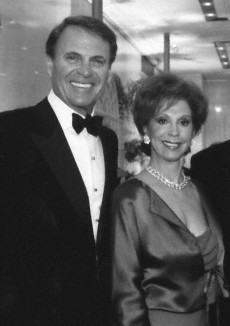
Stuart & Wilma BernsteinIn April 2000, Lawrence J. Wilker, president of the Kennedy Center and its board of trustees, announced he was leaving tostart an Internet entertainment service. After a full-scale search for a suitable replacement, the board selected MichaelKaiser, director of London’s Royal Opera at Covent Garden. Kaiser has achieved worldwide recognition for both his “businesssavvy and passion for the arts” and is said to be a fundraising genius. As Kaiser takes over on February 1, 2001, the composition of the board (which includes 28 Presidential appointees and 18 exofficio members designated by Act of Congress) will have already undergone some change as a result of the Novemberelections. Clinton Cabinet members Donna Shalala and Richard Riley will almost certainly be off the board, and a highpercentage of the Presidential appointees—many of whom made substantial financial contributions to the Clinton-Gorecampaigns—can be expected to be replaced. However, because Presidential appointees serve for six years, all would notimmediately lose their seats just because George W. Bush took office. In addition to Kimsey, Presidential appointees who haveplayed outstanding roles over the course of the past year are: Kennedy Center Board chairman James A. Johnson, whose financialcontributions and leadership of the historic endowment drive have been highly praised; FHC Health Systems founder and friendof Bill, Ronald I. Dozoretz and his wife, former DNC fundraiser, Beth Dozoretz (who committed at least $1 million); realestate developer Stuart A. Bernstein and his wife Wilma, who also gave $1 million or more; publisher Frank H. Pearl and hiswife Geryl, who gave “a sizeable gift” in support of the NSO; former Clinton White House Counsel Thomas F. “Mac” McLarty, IIIand his wife Donna; Ann Jordan (wife of Clinton golf buddy Vernon Jordan) who, like Kimsey, serves on both the Kennedy Centerand National Symphony Orchestra boards; and Buffy Cafritz, who joined Mrs. Jordan again in December to reprise theirsuccessful roles as co-chairwomen of the star-studded Kennedy Center Honors Gala, which yielded a record-setting $2 million in1999. 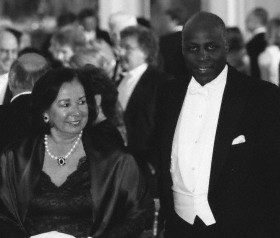
Ann & Vernon JordanTHE NATIONAL SYMPHONY ORCHESTRA (NSO)
The success of the Kennedy Center’s $100 million endowment drive has been fueled by several members of the National SymphonyOrchestra Board of Directors. Roger Sant, billionaire head of AES Corporation (and NSO vice chairman), and his wife Victoriahave given $5 million to endow the music director’s chair, which will help pay a portion of music director/conductor LeonardSlatkin’s $1,060,600 salary. John and June Hechinger, who in 1982 created the Hechinger Commissioning Fund for New OrchestralWorks, remain conscientious and consistently generous supporters, providing at least $1 million toward the current campaign. 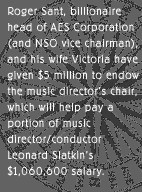 Among the other NSO board members whose combined contributions total nearly $30 million are: Michael Brewer, NSO chairman andpresident of Brewer Group Consulting; Maggie Cole, NSO special events chair and wife of former America Online executive DavidC. Cole; real-estate mogul Joseph E. Robert, Jr.; philanthropist Nancy McElroy “Bitsey” Folger; publisher Austin Kiplinger;Mary Pollin, wife of MCI Center and Wizard’s co-owner Abe Pollin; Nancy Marriott, wife of hotel magnate Richard E. Marriott;and Hilda Ochoa-Brillembourg, president and CEO of the Strategic Investment Group and chairwoman of the 2000 National SymphonyBall. 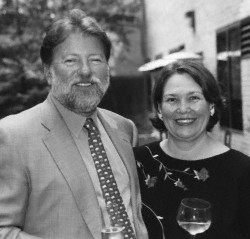
David & Maggie ColeThe NSO’s more than six dozen board members serve three-year terms and are subject to a $15,000 per year “give or get”requirement, which was increased from $10,000 in the spring of 2000. The increase will help offset the cost of the NSO’sapproximately $28 million operating budget and help finance the National Conductor’s Institute created in 1999 to help trainorchestra leaders. THE WASHINGTON BALLET
Like many of her counterparts at other cultural institutions, Washington Ballet board president and chairwoman Kay Kendall islooking to recruit a few high-visibility tech moguls or sports stars to her cause. With that in mind, she recently sought tospark Redskins owner Dan Snyder’s interest by suggesting that perhaps the Redskins and the ballet’s dancers could work outtogether. After all, she reasoned, dancers and football players are all professional athletes. Snyder however, “laughed” atthe idea.Kendall nevertheless remains optimistic and continues to woo high-profile business leaders as well as professional athletesand team owners. She admits she would “love to add Michael Jordan to the ballet’s board.” Not that the ballet is lacking in stars of its own, especially since the arrival of its spectacularly talented new artisticdirector, Septime Webre, who took over in 1999 from founder Mary Day. Webre’s innovative approach has earned rave reviews bothat home and abroad, and energized the board as well. Those who have joined him on the board in the past year include: MichaelP. Bentzen, of Hughes & Bentzen, PLLC; Amy C. Bjarnason, director of operations of Arthur Andersen and Co.’s audit andbusiness advisory services (who is particularly prized as one of the few board members under 35); Cynthia Newport, presidentof Illume Productions, Inc.; and Barbara D. Tannenbaum, a marketing, PR, and events consultant. Board members are asked to give or raise at least $5,000 per year and are eligible to serve two consecutive three-year termsbefore being rotated off to an advisory board position. Advisory board members may be invited back to the board of directorsfor an unlimited number of subsequent terms. Katherine Brittain Bradley, wife of National Journal and AtlanticMonthly publisher David Bradley, is currently the director of the advisory board, and a major new financial contributor. Although the likes of Michael Jordan, Dan Snyder, Abe Pollin, and Ted Leonsis remain conspicuous by their absence, the Balletboard’s PR campaign has nonetheless reaped some rewards from the sports and tech worlds. Most notably, the Ballet’s outreachprograms DanceLinks and the new Dance DC program, which takes classical training to children in the neediest schools, havereceived support from John Ledecky, a financial entrepreneur and Washington Capital’s co-owner, and from the KimseyFoundation. Still, with a yearly budget of nearly $3.5 million and a minimum of $45,000 required annually for pointe shoesalone, the Washington Ballet would welcome additional support. 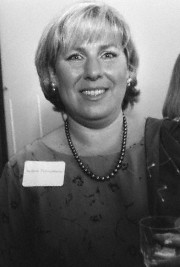
Barbara TannenbaumThere is, as yet, no capital campaign underway although the board has been concentrating on establishing procedures to manageand invest the Ballet’s endowment fund. The endowment, which previously stood at $600,000, grew by $1.9 million in 1999 aftera bequest from the late Laura Phillips, the widow of a founder of the Equitable Life Insurance Company and a longtime patronof the arts who also left sizeable gifts to the Cathedral Choral Society, the NSO ($1 million), and other culturalinstitutions. THE WASHINGTON OPERA
As if sitting on the boards of the Kennedy Center, the National Symphony Orchestra, and his own Kimsey Foundation were notenough, Jim Kimsey is also chairman of the Washington Opera board where he is well-recognized for his exceptionalcontributions. Nonetheless, it is Betty Casey, the board’s “life chairwoman,” who is the Opera’s premier benefactor. Accordingto longtime fellow board member Wilma Bernstein and others, Casey’s generosity and leadership best accounts for the Opera’songoing success.Casey’s gift of over $18 million to purchase the old Woodward & Lothrop’s department store building for a new opera house in1996 led to a sequence of events which caused the Opera to reaffirm its longstanding relationship as an artistic constituentof the Kennedy Center, and increase its number of performances in what was to become a state-of-the-art operatic facilitythere. After cost estimates for the proposed opera house grew past the $200-million mark and were abandoned, the “Woodies” buildingwas sold in 1999. The approximately $10-million profit, which went to create the Eugene B. Casey Endowment Fund, could nothave come at a better time. Stretched to the limit by expenses for world-class productions staged by artistic director PlàcidoDomingo, the company had become surprisingly overextended. The cash infusion relieved the strain, and the board succeeded in extending Domingo’s tenure at least through the year 2004.Originally wooed to Washington by board secretary Selwa W. “Lucky”’ Roosevelt and executive committee chair Christine Hunterfor $250,000 in 1996, Domingo currently receives a $350,000 salary as artistic director. The superstar tenor, however, is fondof saying, “I don’t work for money,” and in fact he has committed $2 million of his own funds to the Opera over the past fewyears. In December, he was among those receiving a Lifetime Achievement Award at the Kennedy Center Honors Gala. Domingo may be the most famous international celebrity associated with the Opera, but even a cursory look at the list of boardmembers reveals the names of such Washington area notables as Reagan-era political powerhouse Michael K. Deaver; publishingheiress Betty Scripps Harvey; Susan Mandl, wife of Teligent’s CEO Alex Mandl; Shirley Small, wife of NSO board member AlbertSmall; fundraiser Jane DeGraff Sloat; Grega Daly, wife of architect Leo Daly, III; Adrienne Mars (wife of candy tycoon John F.Mars); and Hilda Ochoa-Brillembourg. 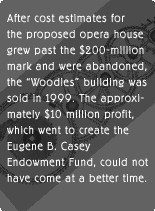 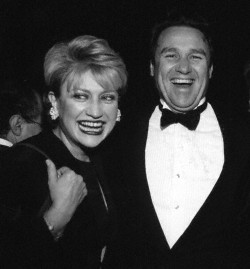
Hilda & Arturo BrillembourgThe Opera has begun to expand physically with the acquisition in September 2000 of new studio in D.C.Takoma Park area, aproject sustained in part by a generous contribution from Adrienne Mars. The studio will house rehearsal and costume storagefacilities, and be the site of community outreach and educational programs. The Opera typically puts on some 170 performances of more than a half dozen operas each year. The budget for the fiscal yearending June 2001 is $31 million, up from $24 million for the prior year. Although the Domingo era has engendered expendituresof over $2 million per opera, there is currently no capital campaign underway. Domingo’s new contract with Los Angeles Operais expected to help defray some expenses, since the two companies will share production costs. Other funds come from boardmembers who are required to provide a $20,000 “give or get” per year, and often contribute much more. Christine Hunter, forexample, has helped underwrite the cost of at least one opera virtually every season for the past twenty years. Betty ScrippsHarvey, while serving as chairwoman of the 1998 Opera Ball, gave a matching grant of $400,000. Whether Harvey will besimilarly generous again bears watching, as she is scheduled to run the Ball again in June. WOLF TRAP FOUNDATION FOR THE PERFORMING ARTS
The Wolf Trap Foundation, which helps administer America’s only national park for the performing arts, recently added SanjuBansal, co-founder and vice president of MicroStrategy, to its impressive list of 55 board members. Other members prominent inthe new economy (most with businesses nearby in Northern Virginia’s high-tech corridor) include: AOL’s Kathy Bushkin; JosephA. Reyes, of Orion Enterprises; Teligent’s Kirby G. “Buddy” Pickle, Jr.; and Lou Scanlan, president of UUcom, Inc.Scanlan describes Wolf Trap as “a quality-of- life home run for our region”’ and hopes to help Wolf Trap “make the techconnection, both from a people and tools perspective.” “At Wolf Trap,” she adds, “we embrace a little bit of heaven,” adescription made all the more real with last year’s airing of the videotape of the Project Bandaloop dancers soaring throughthe skies above Yosemite National Park, even as the dancers performed live suspended over the Filene Center’s stage. Thesensational multimedia presentation was just one example of the broad spectrum of performing arts the Foundation and its boardseek to promote as they strive toward artistic innovation and diversity, aided by twenty-first-century technology. 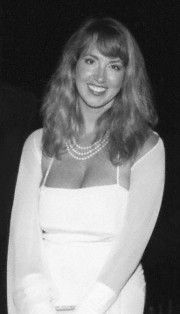
Holidae HayesHolidae Hayes, the vivacious blonde whose name has been linked with Jim Kimsey’s, is another enthusiastic member of the WolfTrap Foundation board. Hayes, who says she is “a Wolf Trap fanatic,” joined the board about two years ago at the invitation ofWolf Trap Foundation board president and CEO Terrance Jones. She views the board’s membership as “an eclectic mix” and creditsWolf Trap with being “one of the first [arts institutions] to recognize the changes in the area’s economy and reach beyond thetraditional list [of potential board members]” to bring more diverse, younger people into the fold. As a consequence,”thereare many tech people on the board, all of whom share a passion and are willing to give 120 percent to ensure that theperforming arts and Wolf Trap achieve greater prominence and exposure in the new century, and provide something for everyone. Eager to take advantage of the healthy economy to secure its financial future, Wolf Trap has launched “The Campaign,” headedby board member and longtime Wolf Trap supporter Earle C. Williams. The goal is to raise $21 million to increase Wolf Trap’sendowment funds and to build a National Center for Education next to the Barns. Currently the endowment stands at $17 million. Even with its new capital campaign, Wolf Trap’s board members are still subject to the same $5,000 per year “give or get”requirement which has been in force for over a decade. Typically, board members are not asked to serve more than twothree-year terms. They are also asked to rotate off the board for one year between terms. Exceptions to the rule are certainofficers, including the First Lady, who is honorary chairwoman. THE SHAKESPEARE THEATRE
The Shakespeare Theatre’s $10 million capital campaign, announced in April of 2000, has already secured $9.15 million for fourseparate board-approved funds, including: $1.5 million for baseline support for the “Free For All Shakespeare in the Park”series, $2 million for the purchase of a new building for administrative offices, another $2 million for start-up costs andscholarships for a new Academy for Classical Theater, and additional millions to establish an endowment. Perhaps not socoincidentally given the Bard’s British origins, Lady Meyer, wife of British Ambassador Sir Christopher Meyer, is one of theShakespeare Theatre’s board members. Another recent addition the board is Miles Gilburne, senior vice pres-ident of corporatedevelopment at America Online. As the personification of the prototypical new powerbroker, his arrival on the board, as itseeks to raise $10 million—roughly the equivalent of one year’s operating budget— is a major coup for board chairman LandonButler and the theater as a whole.Butler, who is president of Landon Butler & Company, which invests pension funds in real estate, has been a ShakespeareTheatre board member since 1997. He took over as board chairman from Lawrence A. Hough in 1999, and is enjoying his leadershipof what he terms, “the best classical theater in the country.” Meanwhile, Hough remains on the board as chairman of theCampaign for the Shakespeare Theatre. 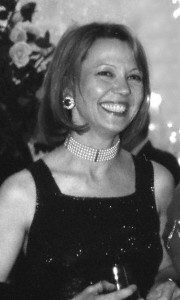
Lady Catherine MeyerIn addition to Gilburne, first-year board members include Kenneth L. Adelman, Heidi Berry, Susan Williams, and TheodoreSedgwick, all of whom were elected in June 1999. Adelman was director of the U.S. Arms Control and Disarmament Agency during the Reagan Administration and has co-authored abook on Shakespeare and management appropriately titled Shakespeare in Charge. He has also been a Shakespeare professorat GW. Berry, a Giant Foods’ heiress, is a free-lance journalist for the Washington Post and a former Washington editor ofArt & Auction magazine. In addition to her membership on the Shakespeare Theatre’s board, she also sits on the board ofthe Washington Opera. She is the wife of Washington lawyer and lobbyist Max Berry, who serves as chairman of the SmithsonianNational Board. Williams is president and a co-founding partner of Bracy, Williams & Company, a government and public affairs consulting firm.She has also chaired the Greater Washington Board of Trade. Sedgwick is president of Sedgwick Publishing and a member of the Folger Shakespeare Library Board and the Civil War Trust. In June of 2000, the board welcomed Sidney Harman, head of Harman International Industries, an audio and video equipmentempire. His commitment to the performing arts was demonstrated earlier in the year when he and his wife Jane, a formerCalifornia Congresswoman, pledged more than $1 million to the Kennedy Center’s endowment. John Hill, Jr., a CPA CGFM with Arthur Andersen, was also elected in June of 2000, as was Catherine Stevens, the wife of Sen.Ted Stevens, the chairman of the Senate Appropriations Committee. Catherine is also a trustee of the Washington Opera. Each of the Shakespeare Theatre’s 45 board members have reportedly been subject to an annual $10,000 “give or get” in additionto providing a donation toward the Theatre’s capital campaign. They serve one four-year term and participate on at least onecommittee and on task forces. However, according to the Theatre’s development office, requirements for board memberships areunder review and may be redefined. THE PHILLIPS COLLECTION
If many Washington arts organizations have done well as a result of the infusion of high-tech blood, some galleries andmuseums are still behind the times. The venerable Phillips Collection, for example, doesn’t expect to have any informationtechnology or dotcom heavies on its board “for at least another six months to a year,” according to Phillips Collectionspokeswoman Lynn Rossotti. Last spring, gallery director Jay Gates told the Washington Post that thus far, he has simplyundertaken to promote “conversations” with individuals in the tech field, not specifically to recruit future board members,but “to help facilitate the museum’s move into the 21st century.” That Gates’ approach has begun to pay off financially, wasevidenced one night in 1999 when John Ledecky and a techie friend decided to match the $375,000 the museum had raised for arefurbishment project. Still the Phillips Collection remains largely a familial and Old Guard institution. Gates, who tookover as director in 1998, is only the second nonrelative to serve in that capacity. The 1992 appointment of his predecessorCharles Moffet, marked the first time that anyone other than a member of the Phillips family had served as director since thegallery was established by Duncan Phillips in 1918 as a memorial to his father and brother. Laughlin Phillips, Duncan’s son,remains as board chairman, with his two children, Gifford Phillips and Liza Phillips on the board as well. His second wife,Jennifer Phillips, is a trustee emeritus. Other board members include WETA’s Sharon Percy Rockefeller, wife of Sen. John D.Rockefeller, IV; and Ann Jordan. Victoria Sant is president of the Phillips Collection board, and Linda Knight is treasurer. 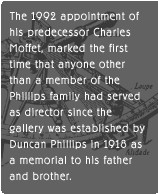 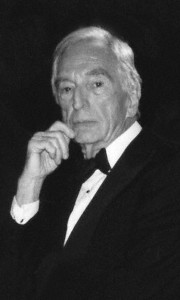
Laughlin PhillipsWhile more than a few board members may be termed old-line Washington types, still others arrived on the board as a resulttheir involvement in the museum’s Corporate Membership Project. Thomas E. Wheeler of the Cellular Telecommunications IndustryAssociation, for example, served as chairman of the Corporate Membership Project’s capital campaign. Meanwhile, VictoriaSant’s husband Roger (of AES Corporation) is also a past chairman of the campaign which since 1982 has raised $4.5 million forspecial exhibits, lectures, and concerts. Additionally, the board’s members are: James Adler; John W. Chandler; James F. Fitzpatrick; Lynne Flexner; Susie Gelman; J.Roderick Heller; Bonnie Himmelman; Alexandra Kahn; Cameron LaClair; Caroline M. Macomber; William C. Paley; Thomas D.Rutherford, Jr.; Patricia Sagon; David W. Steadman; Richard Thompson; Ladislaus von Hoffmann; Alan I. Wurtzel; and James S.Rosebush. Trustees presently serve a maximum of three three-year terms. Financial guidelines for trustees of this prestigiousinstitution appear to be a closely-guarded secret. One sign of innovative change for the museum was 1999’s inaugural presentation of the Duncan Phillips Medal “to pay tribute toliving collectors who embody the founder’s love of art, and his commitment to making it better known to the public.” Cosmeticsexecutive Leonard A. Lauder, chairman of the Whitney Museum of American Art, was the award’s first recipient, while financierand philanthropist David Rockefeller was honored with the Medal on Nov. 3, 2000. A more creative fundraising and outreach effort began September 1, 2000 in Las Vegas when 26 of the Phillips Collection’smasterpieces went on exhibit for six months at the Bellagio Hotel. The trustee-approved show is expected to reap more than $1million for the Phillips Collection with proceeds earmarked for educational programs, exhibitions, and the endowment whichpresently stands at $12 million. According to Rossotti, the Phillips Collection is also planning a Center for the Study and Appreciation of Modern Art,although the museum has not presently inaugurated a public phase of a capital campaign. THE SMITHSONIAN INSTITUTION
Mired in history and tradition, the Smithsonian Institution encompasses the world’s largest museum and research complex. Whilemany people think of The Smithsonian in terms of the nine landmark buildings situated along The Mall, there are in fact 14museums in Washington, two in New York, and as many as 400 offices and research centers including the Smithsonian TropicalResearch Center in Panama. Even the Kennedy Center, although independently administered, is technically a part of TheSmithsonian.Legislation, which created the Smithsonian more than 150 years ago, requires its Board of Regents to have 17 ex officiovoting members “to include the Vice President of the United States, the Chief Justice of the Supreme Court, three members ofthe House of Representatives (appointed by the Speaker of the House), and three members of the Senate (appointed by thePresident pro tempore of the Senate).” Each serves for the duration of their terms in office. Additionally, there arenine private citizens “who are nominated by the board and approved by the Congress in a joint resolution signed by thePresident of the United States.” Each of these “citizen regents” is chosen for his or her knowledge and experience, and servesa six-year term without financial obligation. As a result of these stringent guidelines, the Smithsonian Board of Regents is an impressive list of political heavyweights,academics, lawyers, and top executives, including for example: former Sen. Howard Baker; Louis V. Gerstner, chairman & CEO ofIBM; former University of Chicago president Hanna Holborn Gray; and Frank Gray Spoon, a former Washington Post Companypresident now of Polaris Venture Partners. Unlike many other boards, the Smithsonian Board of Regents is strictly a board of governance and does not engage infundraising. Rather, the Office of Development and in particular the Secretary is responsible for the solicitation andacceptance of such impressive donations as the $80 million given to the Smithsonian Museum of American History by billionairereal-estate developer Kenneth Behring in October of last year. The gift, the largest-ever donation to the Institution,followed Behring’s $20 million- donation to the Smithsonian Museum of Natural History just three years earlier. In January of 2000, Lawrence M. Small, former president and COO of Fannie Mae, took over as the Smithsonian’s new Secretary,replacing I. Michael Heyman who retired after five years of service. Serving the Office of the Secretary in an advisorycapacity, is the Smithsonian national board to which Jean Case, wife of AOL’s Steve Case, and Jane Eisner, wife of Disney’sMichael Eisner, both belong. Its former chairman, Frank Weil and current chairman Max Berry, together with such Washingtonboard members as Marc Leland and Mary Ourisman, raised $1.5 million in the last fiscal year for a donor recognition room. Itwas hardly an inappropriate cause, given that private sector donations to the Smithsonian are at an all-time high. Among theSmithsonian national board members who have made major donations or outstanding contributions, are vice chair and Florida artcollector Patricia Frost; Minnesota community leader Whitney MacMillian; and Texas philanthropist Nancy Brown Negley. 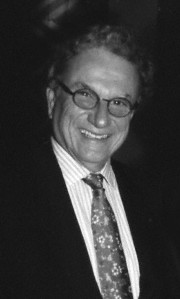
Max BerryThen there is the James Smithson Society, a group of 550 volunteer fundraisers, which provided more than $800,000 in dues andgifts in 2000. The Society bested its previous year’s tally by some $250,000 and added Richard Triska of Houston to its ranksof Endowed Life Members whose one-time gift of $40,000 or more supports priority initiatives in perpetuity. Founded in 1976,the Society’s annual membership fees go toward research and educational projects. Recent projects include the generous supportof the National History Museum’s biodiversity information-dissemination efforts, and contributions toward the preservation ofthe Star-Spangled Banner for the Museum of American History’s new American Presidency Exhibit. There is no Smithsonian-wide capital campaign underway although a new Institution-wide database of supporters has been createdto help meet the various financial requirements of the Institution’s numerous museums, research centers, and offices. Thanksin part to this technological tool, the average annual total for donations has increased ten-fold in the past five years, tonearly $204 million. With the end of fiscal year 2000, the Institution’s total endowment stood at an estimated $755 million,up almost $100 million from the previous year. Another $60– $70 million is needed to complete the National Air and Space Museum’s new Dulles Center, a massive facility whichwill house and display more than 300 of the Museum’s air and space craft’s at Dulles Airport. The lead gift of $60 millionwas provided last fall by California billionaire Steven Udvar-Hazy for whom the Board of Regents has agreed to name thecenter. Udvar-Hazy is president, CEO and founder of International Lease Finance Corporation, an aircraft brokerage andconsulting firm. The Udvar-Hazy Center project is particularly noteworthy in that it is one of the few Smithsonian museums tobe created with private funds (although Congress did put $8 million toward its initial design, and Virginia’s tech-richFairfax County has allotted $300,000 of its fiscal budget for infrastructure support). Howard Baker has volunteered to serveas campaign co-chairman along with Udvar-Hazy in raising the remaining funds required for completion. If the Smithsonian’s regents do not typically engage in private fundraising activities, they do lobby Congress for increasedappropriations, though not always successfully. Smithsonian officials say the Institution needs $100 million annually for atleast the next five years to support restoration and expansion. Congress, however, has approved only $67.5 million for repairsand construction for the Smithsonian in the new fiscal year. Not only are many of the Smithsonian museums showing the wear andtear of being part of the most visited museum complex in the world, but the Smithsonian is physically unable to display morethan a paltry three to four percent of its 141-million artifacts and treasures. Consequently, it could make good use of someof the area’s new economy dollars to redress these concerns. 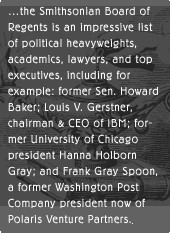 The Smithsonian also needs tech expertise to digitally display its wealth of items cyberspace and provide three-dimensionalcomputer images of all its possessions “with each item morphed back to its place of origin in the natural world.” The goal ofan all-inclusive electronic Smithsonian was first articulated by past Secretary I. Michael Heyman and is made all the moreappealing in light of the fact that while the Institution has some 40 million visits per year, its Website gets that many eachmonth. In 1999, the Museum of Natural History opened its $40.6-million Discovery Center featuring 3-D projections from theSamuel C. Johnson IMAX Theater’s six-story screen. But, admission is not free, and like the Udvar-Hazy Center, the ambitiousconstruction project has had to be funded almost entirely by private sponsors. Indeed, it is only thanks to $5 million fromthe Discovery Channel’s parent company Discovery Communications, and another million from Samuel C. Johnson (the man who madeS. C. Johnson Wax a household name), that the Smithsonian Natural History museum was finally able to begin this project someten years after it was first proposed. The Federal Government did approve $5 million for the National Zoological Park, whichthe Smithsonian also runs. At the insistence of Rep. Ralph Regula of Ohio, barnyard animals will soon have equalrepresentation with the animal kingdom’s more exotic species, including the Sumatra tigers born at the zoo last year, and thenewly- arrived pair of pandas on loan the U.S. from China for a ten-year period $1 million a year. The addition of domesticlivestock to the zoo’s collection reflects the board’s bent toward diversity and inclusion. Other worthy examples are theplans for a Museum of the American Indian on the Mall, and the creation of a national board for the Smithsonian Center forLatino Initiatives. HIRSHHORN GALLERY AND SCULPTURE GARDEN
Currently headed by chairman Robert Lehrman, an heir to the Giant Foods fortune, the Hirshhorn’s board is moving to achievegreater community involvement and raise more direct private funding. Typically, Hirshhorn board members are proven collectors,and preferably wealthy. Since 1988, for example, Lehrman has given the Hirshhorn over $1 million in art and financial support,earning him a plaque on the donor’s wall of honor. But other trustees are generous as well, including three who have made acombined pledge of $250,000 toward the Clifford Stills exhibit scheduled for summer 2001.In 2000, the Hirshhorn board of trustees welcomed its first Internet guru, Audrey Weil of Columbus, Ohio. As the generalmanager for CompuServe Internet Services, a division of AOL, “her vast experience with new technology will,” according tomuseum director James T. Demetrion, “help the museum reach out to and interact with the art-going public of the 21st century.”The board has also welcomed new members from the Washington community, including philanthropists/ collectors Jacqueline Lelandand Barbara Levine. Rounding out the list of the board’s most recent additions are Goldman Sachs financier Steven Mnuchin fromNew York; Steven Oliver, a collector and business executive from California; and John Pappajohn, an Iowa businessman who hasdonated a Tony Cragg sculpture to the museum. Despite these new additions, the board remains nine short of its allowable 25member limit. The vacancies are expected to be filled on a gradual basis as likely prospects are identified. 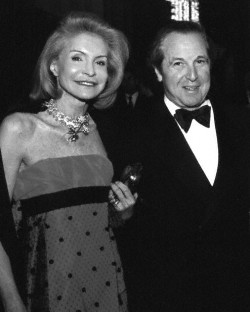
Jacquelin & Marc LelandBoard members now serve four instead of six-year terms, and may not serve for more than twelve years. As a Smithsonian museum,the Hirshhorn does not hold its board members responsible for providing any so-called “give or get” contribution. One mightexpect that a museum of modern and contemporary art would move with the times, and indeed the Hirshhorn Gallery and SculptureGarden is doing just that as it seeks greater support from the private sector. The Hirshhorn has a development office, and tomark the Gallery’s 25th anniversary, it staged its first-ever fundraiser in October 1999. The event was co-chaired by Lehrmanand Olga Hirshhorn, the widow of Joseph H. Hirshhorn, the museum’s founder, and by Smithsonian regents Sen. William Frist andDaniel Patrick Moynihan. It raised $200,000 to fund the Gallery’s publications and redesign its Web site. Last year, the board also agreed to establish the Annual Circle to help raise contributions of any size. Gifts from some 100individuals since July of 2000 brought in $40,000 to fund the Gallery’s Directions Exhibitions “which support cutting-edgeartists.” The Gallery’s acquisitions endowment is $35 million. THE NATIONAL GALLERY OF ART
The National Gallery, which was created in 1937 by Andrew Mellon, has a small, tightly-knit board of trustees divided into twoseparate membership categories. Ex officio trustees include the Secretary of the Smithsonian Institution; the ChiefJustice of the Supreme Court; the Secretary of State; and the Secretary of the Treasury. Private trustees are chairman RobertF. Erburu, former chairman of the board of The Times Mirror Company, who last fall succeeded Alexander Mellon Laughlin;president Robert H. Smith, of the Charles E. Smith (real estate) Companies fortune; Los Angeles art collector Julian Ganz,Jr., president of McMahan Furniture Stores; David O. Maxwell, former chairman of Fannie Mae, who joined the board in 1999; andnewest member, philanthropist and Phillips Collection president Victoria P. Sant. Members serve a ten-year term and may bere-elected. Trustees emerita are Ruth Carter Stevenson and Louise Whitney Mellon.While trustees are primarily occupied with the acquisition of art, the National Gallery’s board made headline news in Novemberof 2000 when it agreed to return a Nazi-looted masterpiece to the rightful owner’s heirs. In approving the return of StillLife With Fruit and Game by the 17th-century artist Frans Synder, the National Gallery became the first publicly-fundedinstitution to part with art stolen by the Nazis in World War II. 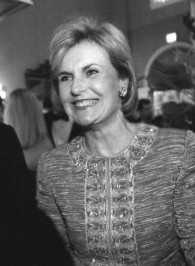
Victoria SantAlthough there are no official financial requirements for board members, private donations have paid for every piece of art inthe collection. A four-year capital campaign which ended in 1998 raised $125 million, $20 million more than the target goal.The following year witnessed a substantial increase in the Gallery’s growing endowment with the addition of approximately $75million in cash from the estate of Paul Mellon, the founder’s son. Mellon also left a sizeable collection of art, includingnumerous works by Degas, as a gift to the museum. The current value of the Gallery’s permanent restricted endowment fund is animpressive $304 million. In addition, the Federal Government authorized $64.7 million for maintenance of the National Galleryfor the current fiscal year. Although the National Gallery of Art has not added any high-profile technology names to its board, it does have a Collector’sCommittee to which the omnipresent Jim Kimsey belongs. Moreover, it now offers virtual tours of its collection via theInternet and has a Web site aimed specifically at children. Also in keeping with its role of exhibiting and fostering theunderstanding of art, in 1999 the National Gallery opened a sculpture garden, a gift to the nation from The Morris andGwendolyn Cafritz Foundation. THE CORCORAN GALLERY OF ART
The Corcoran’s beautiful beaux-arts building has earned a reputation as a favorite venue for tech titans. That support and thefact that AOL’s mega-wealthy Robert Pittman is on its board are particularly appreciated now that the Corcoran, D.C.’s largestnon-Federally- owned museum, is adding “a new and final wing.”Those who followed Pittman’s divorce (from his socialite, mountain-climbing former wife) and the ensuing dispute overownership of a particular painting, may not be surprised that the father of MTV is an art lover who sits on the board of oneof the capital’s most revered repositories of cultural wealth. Pittman gave at least $25,000 to $50,000 to the Corcoran in thefiscal year ending June 30, 2000. Also serving on the board is high-tech venture capitalist Emanuel J. Friedman, whoseFriedman, Billings, Ramsey Group Inc. gave between $25,000 and $50,000 to the museum in the last fiscal year as well. Trusteescredited for “enormous energy and generosity” include president and chairman Ronald D. Abramson, who gave more than $50,000the last fiscal year and is also an art donor; John Landrum Bryant and Patricia Bauman (who gave $100,000 or more); Eleanor F.Hedden and her husband John ($25,000- plus); and John and Anne Hazel ($25,000- plus); and vice chairman Duane W. Beckhorn, whogave at the President’s Council level of $10,000-plus. Other board members who made significant contributions include Otto Ruesch, chairman of the Campaign Steering Committee (whois also expected to co-chair the Kennedy Center’s Spring Gala in 2001 with his wife Jeanne); Policy Planning Committeechairman Paul I. Corddry and his wife Charlotte, who contributed at least $25,000; and Building and Grounds Committee chairmanRobert W. Truland, who also gave $25,000 or more. 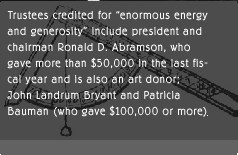 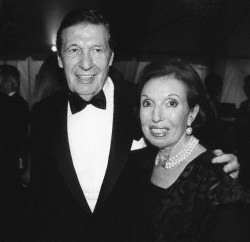
Mr. and Mrs. Robert LinowesStill other donations came from board member R. Robert Linowes and his wife who gave $10,000; Christopher Niemczewski andPerry Chapman who together gave at least $25,000; Carolyn Alper who made a similar contribution; and Martha Ann Healy, whosefamily foundation gave $100,000 or more. The newest members to join the Corcoran board are Robert Millard, managing directorof Lehman Brothers; Howard Milstein of the New York real estate family, whose Milstein Brothers Foundation gave $10,000 in thepast fiscal year. Members may serve for as many as three three-year terms. There is no official “give or get” requirement, oras one museum official put it, “We do not bill our board members.” Despite the generous contributions listed above, the board may find itself in the midst of a public capital campaign thisyear. The Corcoran still needs at least $50 million to help cover the estimated $100 million for construction of its new wing.The modern extension, designed by famed architect Frank Gehry, will house offices, studios, and a children’s center. While thefinal pricetag has yet to be determined, there has been some speculation that the museum’s ambitious plans may be costprohibitive. However, the Corcoran’s endowment is currently valued at $32 million, and at least one spokesperson for themuseum adamantly denies that money is an issue, insisting that the museum “will fulfill its dream.” Moreover, the Corcoran’s ability to attract financial support from the tech community seems assured, at least for the timebeing. Techies flock to the beautiful building, with its beloved atrium and Ionic columns, to throw private parties and enjoyeach other’s company and to promote the museum’s mission. BEST BUDDIES
Best Buddies International has also received major support from theVirginia-based tech crowd. Local tech moguls have beenupping the ante by increasing the amounts raised at the charity’s annual Washington gala by a half-million dollars in each ofthe last three years. In 1998, Ted Leonsis, president of America Online Studios, and John Ledecky, helped Best Buddies raise$600,000 at its annual gala. In 1999 Leonsis’ wife Lynn, and Proxicom founder Raul Fernandez raised $1.1 million co-chairingthe event at which e-buddies, a program designed to develop relationships with mentally-challenged persons via e-mail, wasannounced. And in 2000, gala chair Michael Saylor, president of MicroStrategy, brought in $1.6 million thanks to his own$200,000 pledge and the support of sponsors such as AOL, Proxicom, and Net2Phone. 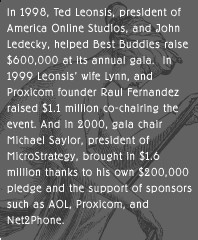 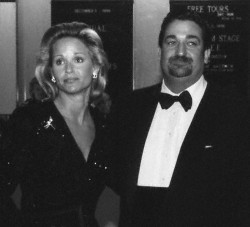
Lynn & Ted LeonsisThe theme of the October 2000 event was “Friendships Through Technology” and it honored Lynn Leonsis and her husband Ted, whosits on the board of Best Buddies International and has the distinction of being the first e-buddy, according to Lisa Derx,director of the Washington Chapter of e-buddies. The gala affair was held at the Potomac home of Sargent and Eunice Shriver,whose son, Anthony Shriver, is the organization’s founder. Mrs. Shriver is a Best Buddies’ board member, as is Olympic GoldMedalist Carl Lewis, and a dozen or so other concerned citizens who “help provide opportunities for socialization andemployment to people with mental retardation.” There is no set financial requirement for board members, who agree to servetwo-year terms and may be renominated. The amounts they contribute vary, although the board has recently created an endowedscholarship fund with the anticipated goal of $1 million and is presently in the process of approving a capital campaign. MAKE-A-WISH FOUNDATION OF THE MID-ATLANTIC, INC.
When choosing new board members, the natural evolution for many area nonprofits was to court real-estate moguls in the 1980s,communications titans in the1990s, and now the dotcom/Internet dynamos. As Ralph Nappi, Jr., president of the Make-A-WishFoundation of the Mid-Atlantic, Inc., points out, “Most charitable organizations now recognize that it is a big mistake not tohave at least one dotcom type, on their board.”The Mid-Atlantic Chapter of Make-A-Wish has recently added Loren Burnett, chief operating officer and co-founder ofFutureNext, a $70-million e-commerce consulting firm based in Tyson’s Corner. Burnett’s entrepreneurial skills and computerexpertise along with his commitment to the Foundation’s mission is sure to be a big plus for the organization, which grantsthe wishes of children combatting life-threatening diseases. Specifically Burnett seeks “to help put in place the Internet structures and computer architecture” required to sustainMake-A-Wish in the new millennium. Already, Internet subscribers can visit its Website to donate funds electronically, or goto sites such as GreaterGood.com to shop on-line to support Make-A-Wish and numerous other charities. 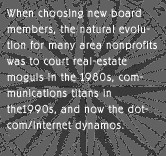 
Ginger PickleMake-A-Wish has also welcomed Tammy Ebaugh, of the newly created Virginia- based advertising firm, Admine.com, to its board.Ebaugh hopes to tap her company’s resources to produce a public-service campaign that will provide adequate financial supportto honor the children’s desires. While a trip to Disneyland was once routine, the Internet has opened up a whole new world of sophisticated and expensiverequests. Consequently, the board was recently forced to downgrade one child’s wish for a dream safari which would have costalmost $30,000, approximately a third of the Mid-Atlantic chapter’s annual wish budget, and six times the cost of the averagewish. Another high-tech connection on the Make-A-Wish board is the newly-elected Ginger Pickle, whose husband, Kirby “Buddy”’ Pickleis president & COO of Teligent. Mrs. Pickle is a star supporter and sponsor of Make-A-Wish, and has helped host theFoundation’s past two fundraising balls, co-chairing last year’s affair with Norma Ramsey, the wife of venture capitalist W.Russell Ramsey. Norma Ramsey, who helped raise almost $600,000 at the 2000 Make-A-Wish charity ball, joined the board inSeptember 2000 and will co-chair the Make-A-Wish ball again in February, this time with Wolf Trap board member Holidae Hayes.The duo is hoping their connections will bring in a quarter-million dollars or more. There is no financial statement of qualification required of board members. To ensure the board stays fresh and in step withthe times, members are allowed to serve only two nonconsecutive, three-year terms. SCHOOL NIGHT’S FIGHT FOR CHILDREN
Not all tech moguls, venture capitalists, or real-estate giants join existing boards. Many have started their own foundationssupport-ing new causes and creating boards comprised of what some have termed “new social activists.” One such activist is JoeRobert, Jr., a real-estate mogul and owner of J. E. Robert Companies. Specifically, Robert has sought to promote thewell-being of children by founding Fight for Children with its highly successful Fight Night and School Night fundraisingevents.Since 1990, Fight Night has raised more than $13 million for some seventy children’s charities including, Make-A-Wish, and itnow bills itself as the largest charity event in the region. School Night has since its inception in 1998, already raised over$11.5 million “to provide educational scholarships to deserving and eligible children in the Washington, D.C. area.”Incredibly $6.6 million of that total came from last fall’s event alone. The success of School Night is a remarkable tributeto Robert and his leadership committee members who operate under a “give or get” mandate of $100,000. Members include: AlbertL. Lord of Sallie Mae; and Eric F. Billings, Emanuel Friedman, William Swanson, and W. Russell Ramsey who together comprisethe high-tech venture capital group of Friedman, Billings, Ramsey Group, Inc. Norma Ramsey is also on the leadership committeerepresenting the W. Russell and Norma Ramsey Foundation. Robert’s wife, Jill, perhaps best known for her role in representingKnock-Out Abuse Against Women, another of the charity events the Roberts sponsor, also makes the committee list. 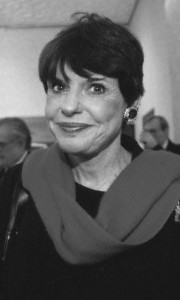
Marlene MalekOther notable committee members include C. Boyden Gray, a prominent lawyer; John Hechinger, Jr.; and Marlene Malek and herhusband Fred Malek, a venture capitalist with Thayer Capital Partners. Also on the committee is James Kimsey, who hosted thefirst School Night Ball. Often described as one of Robert’s best friends, the two philanthropists were profiled together inNewsweek last year. BETTER BOARDS
Despite the obvious interest in the new-economy barons, most area boards still note their overall desire for a diversemembership in terms of skills, backgrounds, and even income levels. They want a mix of men and women, young and old, from alarger geographic area, and with more varied life experiences to bring to the table in support of their wider array ofprograms and burgeoning outreach activities.Perhaps Holidae Hayes summed up the push for diversity most concisely when she expressed the sentiment that, “boards shouldnot be 100% older, wealthy, non-working people.” However, Hayes, who is vice president of the investment research andconsulting firm, Sanford C. Bernstein & Co., Inc., concedes that, “it is a challenge to balance a career and participation ona board,” though she personally sits on four. Now with the advent of the tech world’s “baby billionaires,” board members certainly need not be old. And, no doubt, themedian age of board members will fall somewhat as those who at thirty or thirty-five cash in their stock options and leave therat race behind. Of course some may take on charitable causes or board memberships for no other reason than to be labeled aphilanthropist or patron of the arts, as opposed to being termed retired or even semi-retired. Still others may feel as JohnD. Rockefeller did, that “the power to make money is a gift from God,” and that as a consequence they have a moral obligationto aid the less fortunate. To the present, and despite the proliferation of IT professionals on many local area boards, the majority of the winners inthe new economy are still trying to get a fix on where their energy and dollars might best be spent in keeping with personalvalues and the needs of society at large. Loren Burnett of Make-A-Wish observes “that while the future of area nonprofits isvery bright...the larger challenge is to get the newly-minted millionaires [onto boards and into charities]”. Hayes meanwhilesuggests that often all that is required to get people involved is to “just ask them, since it is an honor to be invited [tosit on a board] and so hard to say no to a good cause.” However, she admits that some people, whom she calls “drive-bycitizens,” may have to be cajoled into doing their fair share. Of course, many people are best taught by example, and with all of the dedicated men and women discussed herein and stillothers leading the way, it should not be long before most of the techie tycoons and newly-affluent members of theGreaterWashington Area, have found their niche. Moreover, Jonathan Ledecky may have provided an added incentive to those stillon the sidelines when he was quoted in a Washington Post article last year, as saying, “There has been a correlationbetween my charitable giving and my business success.” As a consequence, more and more young people from all walks of life maydecide to discover for themselves what a wonderful opportunity the charity circuit is for networking. Certainly, most people would agree that serving any of the organizations included in this survey is mutually beneficial onmany levels. Ask any of the board members why they serve, and you will likely hear that it is because it is “personallyfulfilling” or “so challenging and rewarding” to be able to make a positive difference in the lives of others and to benefitsociety as a whole. 
|

